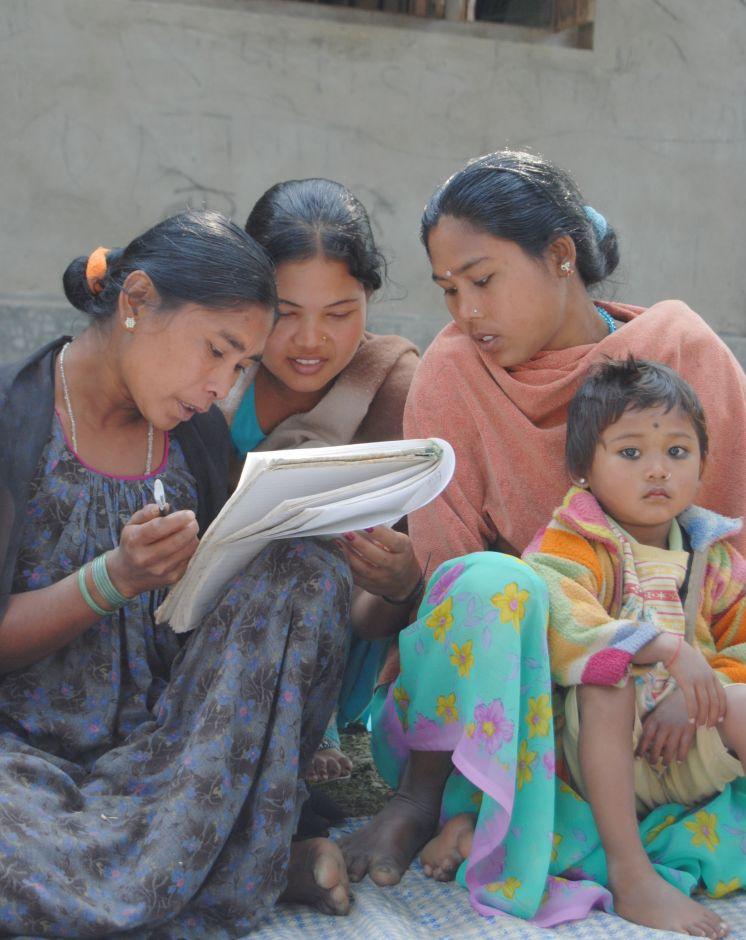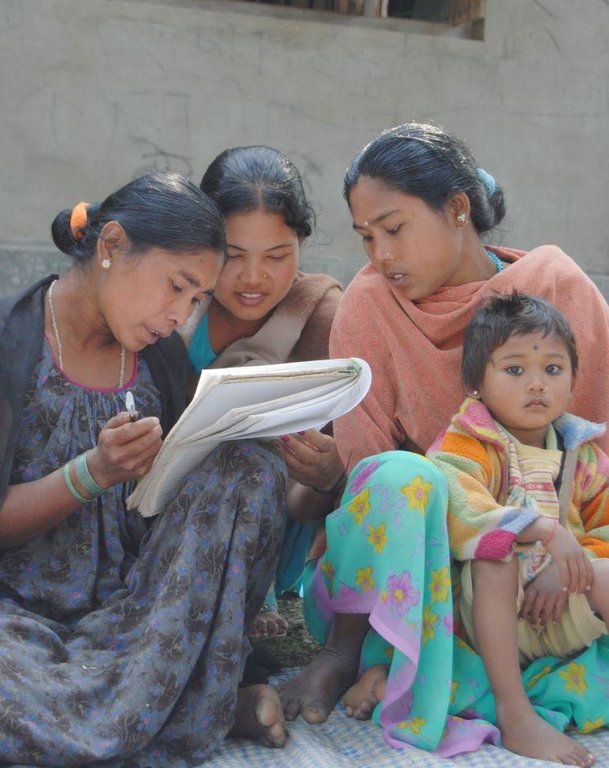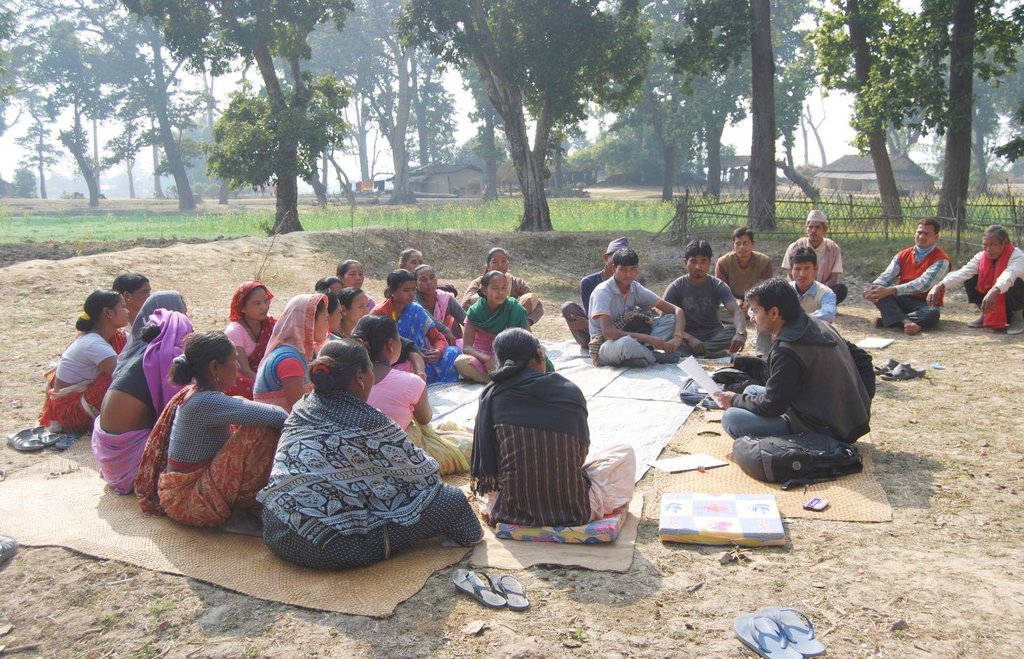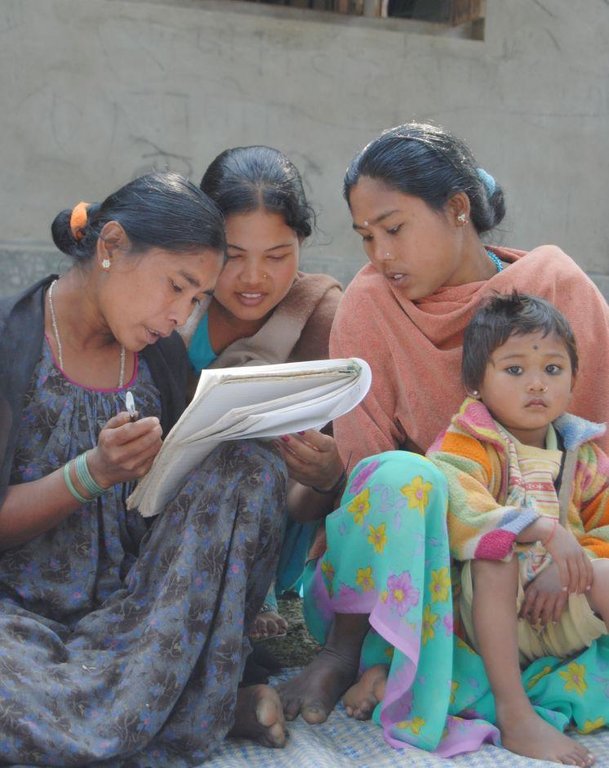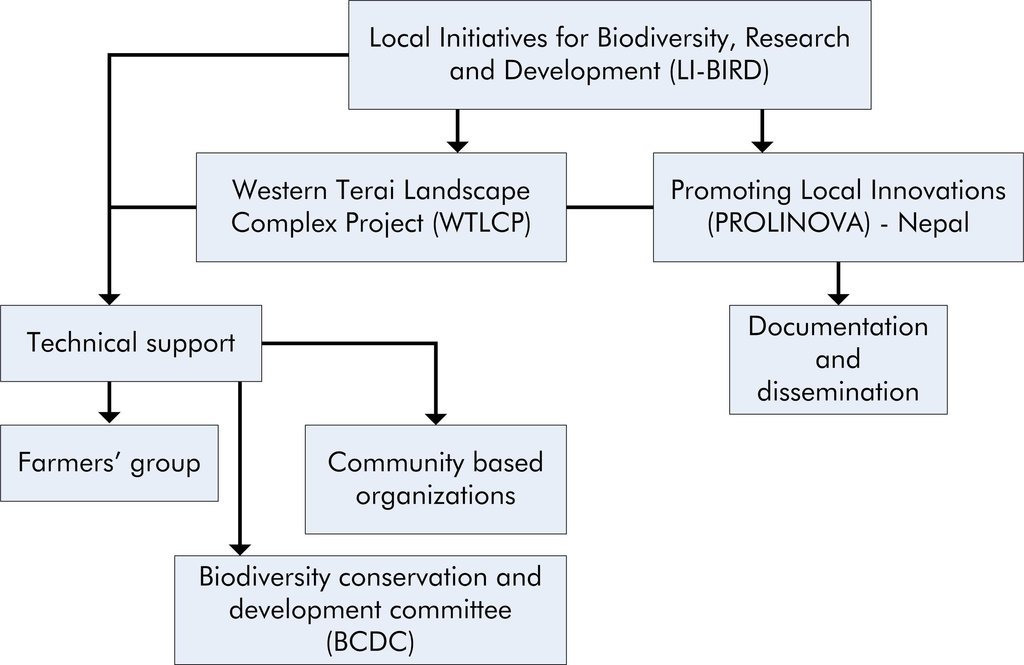Learning about no-till methods through farmer-to-farmer dissemination [Nepal]
- Criação:
- Atualização:
- Compilador/a: Shreedip Sigdel
- Editor: –
- Revisor: Fabian Ottiger
Kisan - Kisan bichko prasal dwara khanjot nagarikana kheti garne tarika ko addhyan (Main Contributor: Krishna Lamsal, LI-BIRD)
approaches_2531 - Nepal
Veja as seções
Expandir tudo Recolher tudo1. Informação geral
1.2 Detalhes do contato das pessoas capacitadas e instituições envolvidas na avaliação e documentação da abordagem
Especialista em GST:
Especialista em GST:
Lamsal Krishan
+977 61 5535357/5526834 / 9841483937 (M)
naturekrish@gmail.com / klamsal@libird.org,
Local Initiatives for Biodiversity, Research and Development (LI-BIRD)
P.O.Box 324, Gairapatan, Pokhara
Nepal
Nome da(s) instituição(ões) que facilitou(ram) a documentação/avaliação da Abordagem (se relevante)
ICIMOD International Centre for Integrated Mountain Development (ICIMOD) - NepalNome da(s) instituição(ões) que facilitou(ram) a documentação/avaliação da Abordagem (se relevante)
Kathmandu University (KU) - NepalNome da(s) instituição(ões) que facilitou(ram) a documentação/avaliação da Abordagem (se relevante)
Local Initiatives for Biodiversity, Research, and Development (LI-BIRD) - Nepal1.3 Condições em relação ao uso da informação documentada através de WOCAT
Quando os dados foram compilados (no campo)?
01/03/2013
O compilador e a(s) pessoa(s) capacitada(s) aceitam as condições relativas ao uso de dados documentados através do WOCAT:
Sim
1.4 Referência ao(s) questionário(s) sobre tecnologias da GST
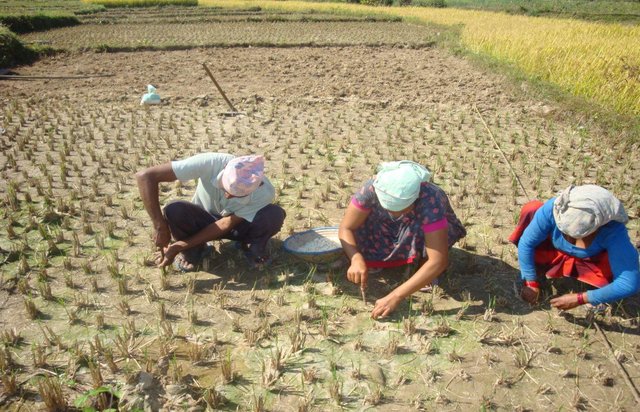
No-till garlic cultivation [Nepal]
No-till is a farming system in which the seeds are planted directly into untilled soil which still contains the previous crop residues. No-till cultivation of garlic is practiced in the tropical lowland districts of western Nepal where garlic is sown directly into the soil after the paddy is harvested.
- Compilador/a: Shreedip Sigdel
2. Descrição da abordagem de GST
2.1 Descrição curta da abordagem
Farmer to farmer dissemination of information on no-till methods for garlic cultivation technology
2.2 Descrição detalhada da abordagem
Descrição detalhada da abordagem:
Aims / objectives: Farmers can learn about alternative or newer methods by sharing their experiences with one another. In this approach, farmers shared information and knowledge on no-till garlic cultivation technology.
Methods: Since no-till methods are not widely known in the area, the approach aimed to increase awareness of the many features of the technique and its benefits. Through farmer-to-farmer dissemination, communities can learn about the various aspects of no-till for crop residue management, resource use, and how it can reduce labour costs. These discussions highlight the environmental and social benefits of no-till methods especially with respect to moisture retention, soil and water conservation, and climate change adaptation.
In 2009, Local Initiatives for Biodiversity, Research, and Development (LI-BIRD), piloted and validated no-till farming in Nepal as a measure for soil and water conservation through the Western Terai Landscape Complex Project (WTLCP) and the Promoting Local Innovation (PROLINNOVA) programme. The dissemination was multi-faceted and the farmers remained engaged throughout the discussions, which included both talks and group participation. Farmers’ groups, community-based organizations, biodiversity conservation groups, and development committees at the village level were given training and technical inputs. This community-level interaction encouraged farmers to discuss with one another as well as to head out to the field for demonstrations and observations. After no-till garlic cultivation was successfully piloted, it was widely adopted by farming communities and especially the indigenous Tharu communities of western Nepal.
2.3 Fotos da abordagem
2.5 País/região/locais onde a abordagem foi aplicada
País:
Nepal
Especificação adicional de localização:
Gadariya VDC, Kailali District
2.6 Datas de início e término da abordagem
Indique o ano de início:
10
2.7 Tipo de abordagem
- Iniciativa/inovação local recente
2.8 Principais metas/objetivos da abordagem
The Approach focused mainly on SLM with other activities (agricultural and livelihood related technology)
• To disseminate information and know-how on no-till methods
• To increase awareness among the farmers on the benefits of no-till methods and crop residue management
• To increase awareness of the environmental and social benefits of no-till methods and the role that it can play in adaptation to climate change
The SLM Approach addressed the following problems: • Lack of awareness about low cost soil and water conservation technologies that address farmers' needs
• Initially there was weak institutional support for organizing discussion sessions
2.9 Condição que propiciam ou inibem a implementação de tecnologia/tecnologias aplicada(s) segundo a abordagem
Normas e valores sociais/culturais/religiosos
- Inibitivo
No-till methods are not widely known in the area
Treatment through the SLM Approach: The group was readily convinced of the economic benefits of no-till methods (especially for garlic production) and this was essential in persuading them to accept the technology.
Disponibilidade/acesso a recursos e serviços financeiros
- Inibitivo
Financial resources lacking; this group does not have links to financial institutions.
Treatment through the SLM Approach: Farmers used their own resources
Outro
- Inibitivo
Water availability is poor.
Treatment through the SLM Approach: No-till methods help to conserve moisture in the soil.
3. Participação e papel das partes interessadas envolvidas
3.1 Partes interessadas envolvidas na abordagem e seus papéis
- Usuários de terra/comunidades locais
Community based organization, farmers group
About 60% of those who attend meetings are women. Most of the field activities such as planting and harvesting are performed by women. The indigenous Tharu communities are adopting this technology.
- Organização não governamental
LI-BIRD
3.2 Envolvimento do usuários de terra/comunidades locais nas diferentes fases da abordagem
| Envolvimento do usuários de terra/comunidades locais | Especifique quem estava envolvido e descreva as atividades | |
|---|---|---|
| Iniciação/motivação | Automobilização | Community meetings organized to discuss the new technology and how it could be implemented locally |
| Planejamento | Participativo | Interactive discussion groups and focal groups organized in the community |
| Implementação | Automobilização | Individual farmers implemented the technology on their land without external support. LI-BIRD provided in-kind and technical information and support. |
| Monitoramento/avaliação | Automobilização | LI-BIRD monitored the implementation of the technology and helped to evaluate the outcome. They collected and analysed data in order to highlight the soil and water conservation aspects of the no-till method and disseminated this information. |
| Research | Nenhum |
3.3 Fluxograma (se disponível)
Descrição:
LI-BIRD piloted and validated no-till farming in Nepal as a measure for soil and water conservation through the Western Terai Landscape Complex Project (WTLCP) and the Promoting Local Innovation (PROLINNOVA) programme. Technical support was extended to farmers’ groups, community-based organizations, biodiversity conservation groups, and development committees at the village level.
Autor:
(A. K. Thaku)
3.4 Decisão sobre a seleção de tecnologia/tecnologias de GST
Especifique quem decidiu sobre a seleção de tecnologia/tecnologias a serem implementadas:
- Principalmente usuários da terra, apoiados por especialistas em GST
Explique:
Decisions on the method of implementing the SLM Technology were made by mainly by land users supported by SLM specialists
4. Suporte técnico, reforço das capacidades e gestão do conhecimento
4.1 Reforço das capacidades/formação
Foi oferecida formação aos usuários da terra/outras partes interessadas?
Sim
Especifique quem foi capacitado:
- Usuários de terra
Caso seja relevante, especifique gênero, idade, status, etnia, etc.
Land users and community mobilizers from the indigenous Tharu communities were given training on no-till method and crop residue management.
Tipo de formação:
- Áreas de demonstração
Tipo de formação:
- Participatory methods and approaches
4.2 Serviço de consultoria
Os usuários de terra têm acesso a um serviço de consultoria?
Sim
Especifique se foi oferecido serviço de consultoria:
- Em centros permanentes
Descreva/comentários:
Name of method used for advisory service: Capacity building training; Key elements: Capacity building took place through site visits and extension materials as well as through discussions and exchanges
4.3 Fortalecimento da instituição (desenvolvimento organizacional)
As instituições foram fortalecidas ou estabelecidas através da abordagem?
- Sim, moderadamente
Especifique a que nível (níveis) as instituições foram fortalecidas ou estabelecidas:
- Local
Especifique o tipo de apoio:
- Reforço das capacidades/formação
- Technical support
Dê mais detalhes:
LI-BIRD supported farmers groups, biodiversity conservation and development committees, and community-based organizations by providing hands-on training and technical support.
4.4 Monitoramento e avaliação
Monitoramento e avaliação são partes da abordagem?
Sim
Comentários:
technical aspects were regular monitored by project staff, government, land users through observations; indicators: Regular observations by technical staff from LI-BIRD jointly with representatives from biodiversity conservation and development committees, farmers groups, and community-based organizations
socio-cultural aspects were regular monitored by project staff, land users through observations; indicators: Regular observations by technical staff from LI-BIRD jointly with representatives from biodiversity conservation and development committees, farmers groups, and community-based organizations
economic / production aspects were regular monitored by project staff, government, land users through observations
economic / production aspects were monitored by None through measurement
There were several changes in the Approach as a result of monitoring and evaluation: Several changes were observed. People learned both through discussions and by taking a hands-on approach. An initial attempt to replicate the method ended in failure. However, through discussions and technical inputs, the farmers were eventually able to replicate the method and it is now well understood.
5. Financiamento e apoio material externo
5.1 Orçamento anual para o componente de GST da abordagem
Comentários (p. ex. principais fontes de recursos/principais doadores):
Approach costs were met by the following donors: local community / land user(s) (Mostly by the land users; capacity building activities and field demonstration costs were borne by LI-BIRD.): 100.0%
5.2 Apoio financeiro/material concedido aos usuários da terra
Os usuários da terra receberam apoio financeiro/material para a implementação de tecnologia/tecnologias?
Não
5.3 Subsídios para entradas específicas (incluindo mão-de-obra)
- Nenhum
5.4 Crédito
Foi concedido crédito segundo a abordagem para atividades de GST?
Não
6. Análise de impactos e declarações finais
6.1 Impactos da abordagem
A abordagem auxiliou os usuários da terra a implementar e manter as tecnologias de GST?
- Não
- Sim, pouco
- Sim, moderadamente
- Sim, significativamente
No-till and better use of crop residues has contributed to improved land management; more moisture is now retained in the soil. Water is in poor supply and vegetable production in this area is limited by the amount of moisture in the soil.
A abordagem concedeu autonomia aos grupos social e economicamente desfavorecidos?
- Não
- Sim, pouco
- Sim, moderadamente
- Sim, significativamente
The indigenous Tharu communities now have some increased cash income from selling their garlic crop.
Did other land users / projects adopt the Approach?
- Não
- Sim, pouco
- Sim, moderadamente
- Sim, significativamente
Community-based organizations, as well as members of other communities and neighbouring districts, have either adopted the method or expressed an interest in learning how to implement it.
Did the Approach lead to improved livelihoods / human well-being?
- Não
- Sim, pouco
- Sim, moderadamente
- Sim, significativamente
Mainly due to increased income from garlic production and reduced labour costs associated with no-till.
Did the Approach help to alleviate poverty?
- Não
- Sim, pouco
- Sim, moderadamente
- Sim, significativamente
mainly due to increased income from garlic production and reduced labour costs. Studies showed a 25% increase in crop yield and reduced labour requirements.
6.2 Principal motivação dos usuários da terra para implementar a GST
- Lucro (lucrabilidade) aumentado, melhora da relação custo-benefício
- Carga de trabalho reduzida
- well-being and livelihoods improvement
6.3 Atividades de sustentabilidade de abordagem
Os usuários da terra podem manter o que foi implementado através da abordagem (sem apoio externo)?
- Sim
Caso afirmativo, descreva como:
This technology has a high probability of being sustainable because it is cost effective and requires minimal technical input (farmers can do it on their own); moreover, it helps with soil conservation.
6.4 Pontos fortes/vantagens da abordagem
| Pontos fortes/vantagens/oportunidades na visão do compilador ou de outra pessoa capacitada |
|---|
| Farmers can easily learn no-till techniques through community participation. The approach is sustainable because it is easy to implement and it appeals to farmers because they appreciate it as a way of reducing labour and increasing crop yields. (How to sustain/ enhance this strength: Continue to give some minor technical support and encouragement.) |
| The approach focused on building capacity by using a hands-on approach similar to how farmers traditionally transfer know-how between themselves. Farmers can adapt and modify the technology as needed to deal with changing conditions in the environment. Financial inputs by external organizations are not needed. (How to sustain/ enhance this strength: Continue to give some minor technical support and encouragement.) |
6.5 Pontos fracos, desvantagens da tecnologia e formas de superá-los
| Pontos fracos/vantagens/riscos na visão do compilador ou de outra pessoa capacitada | Como eles podem ser superados? |
|---|---|
| Market linkages are poor and the scope to scale up is also small. | The establishment of stronger market linkages would motivate farmers to attempt commercial cultivation. |
7. Referências e links
7.1 Métodos/fontes de informação
- visitas de campo, pesquisas de campo
- entrevistas com usuários de terras
Links e módulos
Expandir tudo Recolher tudoLinks

No-till garlic cultivation [Nepal]
No-till is a farming system in which the seeds are planted directly into untilled soil which still contains the previous crop residues. No-till cultivation of garlic is practiced in the tropical lowland districts of western Nepal where garlic is sown directly into the soil after the paddy is harvested.
- Compilador/a: Shreedip Sigdel
Módulos
Não há módulos


